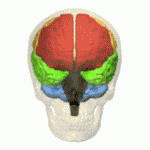
The frontal lobe of the human brain is both relatively large in mass and less restricted in movement than the posterior portion of the brain.[1] It is a component of the cerebral system, which supports goal directed behavior.[2] This lobe is often cited as the part of the brain responsible for the ability to decide between good and bad choices, as well as recognize the consequences of different actions. Because of its location in the anterior part of the head, the frontal lobe is arguably more susceptible to injuries. Following a frontal lobe injury, an individual's abilities to make good choices and recognize consequences are often impaired. Memory impairment is another common effect associated with frontal lobe injuries, but this effect is less documented and may or may not be the result of flawed testing.[3] Damage to the frontal lobe can cause increased irritability, which may include a change in mood and an inability to regulate behavior.[1] Particularly, an injury of the frontal lobe could lead to deficits in executive function, such as anticipation, goal selection, planning, initiation, sequencing, monitoring (detecting errors), and self-correction (initiating novel responses).[4] A widely reported case of frontal lobe injury was that of Phineas Gage, a railroad worker whose left frontal lobe was damaged by a large iron rod in 1848 (though Gage's subsequent personality changes are almost always grossly exaggerated).
- ^ a b Lux WE (2007). "A neuropsychiatric perspective on traumatic brain injury". Journal of Rehabilitation Research & Development. 44 (7): 951–962. doi:10.1682/jrrd.2007.01.0009. PMID 18075952.
- ^ Badre D, D'Esposito M (2009). "Is the rostro-caudal axis of the frontal lobe hierarchical?" (PDF). Nature Reviews Neuroscience. 10 (9): 659–669. doi:10.1038/nrn2667. PMC 3258028. PMID 19672274. Archived from the original (PDF) on 2012-01-24. Retrieved 2011-12-31.
- ^ Kim J.S.; Kim O.L.; Seo W.S.; Koo B.H.; Joo Y.; Bai D.S. (2009). "Memory Dysfunctions after Mild and Moderate Traumatic Brain Injury : Comparison between Patients with and without Frontal Lobe Injury". Journal of Korean Neurosurgical Society. 46 (5): 459–467. doi:10.3340/jkns.2009.46.5.459. PMC 2796352. PMID 20041056.
- ^ Lezak M.D. (1989). Assessment of psychosocial dysfunction resulting from head trauma. In: Lezak MD, editor. Assessment of the behavioral consequences of head trauma. New York (NY): A. R. Liss; 113–43.